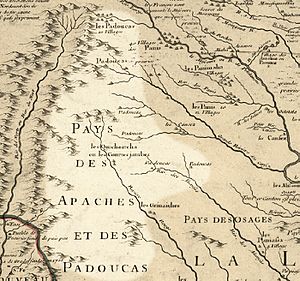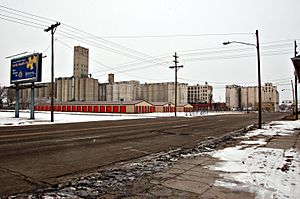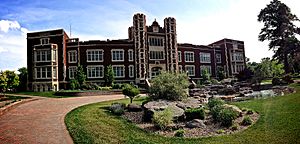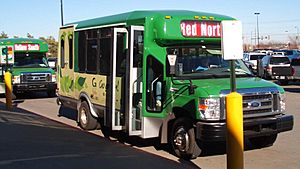Salina, Kansas facts for kids
Quick facts for kids
Salina, Kansas
|
|
|---|---|
|
City and County seat
|
|

Salina water tower (2013)
|
|
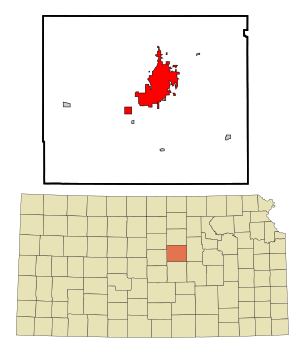
Location within Saline County and Kansas
|
|

|
|
| Country | United States |
| State | Kansas |
| County | Saline |
| Founded | 1858 |
| Incorporated | 1870 |
| Government | |
| • Type | Council-Manager |
| Area | |
| • Total | 25.74 sq mi (66.65 km2) |
| • Land | 25.70 sq mi (66.57 km2) |
| • Water | 0.03 sq mi (0.09 km2) |
| Elevation | 1,227 ft (374 m) |
| Population
(2020)
|
|
| • Total | 46,889 |
| • Density | 1,821.6/sq mi (703.51/km2) |
| Time zone | UTC-6 (CST) |
| • Summer (DST) | UTC-5 (CDT) |
| ZIP code |
67401-67402
|
| Area code | 785 |
| FIPS code | 20-62700 |
| GNIS ID | 476808 |
Salina is a city in Kansas, United States. It is the main city of Saline County. In 2020, about 46,889 people lived there.
In the early 1800s, the Kanza tribe lived in this area. In 1858, settlers from Lawrence started the Salina Town Company. They faced dangers from other tribes in the west. The town was named after the Saline River, which has salty water. Saline County was formed around the town. In 1870, Salina officially became a city.
Salina was an important trading post on the Smoky Hill Trail. It grew quickly until the American Civil War. People traveling west, gold miners, and local American Indian tribes used it for trade. The city grew again from the 1940s to the 1950s. This was when the Smoky Hill Army Airfield was built for World War II planes.
Today, Salina is a regional trade center for North Central Kansas. It has colleges like the KSU College of Technology and Aviation and Kansas Wesleyan University. Big employers include Tony's Pizza, Exide Battery, and Great Plains Manufacturing.
History of Salina
Early Native American Life
Before Europeans arrived in the early 1700s, the land where Salina is now was part of the Kansa people's territory. France first claimed this area as part of Louisiana. Later, the United States bought it in 1803 as part of the Louisiana Purchase.
French traders made maps of the area. They showed a Kansa village where the Smoky Hill, Saline, and Solomon rivers meet. Other tribes like the Paducas lived nearby.
By the early 1800s, the Republican Pawnee tribe had become powerful in the Smoky Hills. They pushed the Kansa tribe to the northeast of Kansas. The United States built forts to protect trade routes like the Smoky Hill Trail and the Santa Fe Trail. The Smoky Hill Trail went through the Salina area.
The Battle of Indian Rock: 1857
When the first U.S. settlers arrived, tribes like the Cheyenne, Arapaho, and Sioux used the Salina area for hunting. The Kansa, Delaware, and Potawatomi tribes also hunted there. The High Plains tribes did not like the settlers or the relocated Eastern tribes. They often raided the Salina area in the 1850s. These attacks made it hard for people to settle there.
In 1857, Big Chief of the Cheyenne led an attack on a hunting party of the "friendly" Eastern tribes. The hunting party was forced to retreat to a hill by the Smoky Hill River. There, they were joined by more Kaw fighters who had rifles. The defenders fired from behind large rocks. They killed Big Chief and defeated his attacking force. This battle stopped many local raids.
A settler named Christina Campbell later said it was "one of the fiercest and most cruel Indian battles." She described "thousands of arrows" and "Indian Rock, besmeared with blood," showing how important the battle was.
Salina's Founding: 1858–1870

After the High Plains tribes were defeated, it became safer for settlers. In April 1858, William A. Phillips and other settlers from Lawrence founded Salina. They were mostly Scottish Presbyterians and related. They set up their first camp and built the first store near what is now Founders Park. They had to keep their wagons in a circle around their water well to protect against attacks. The Campbells had the first baby born to settlers in the area, also named Christina.
That same month, they officially started the Salina Town Company with the Kansas territory government. The next year, they organized Saline County and made Salina its main town. Salina became an important trading post on the Smoky Hill Trail. It served immigrants going west, gold miners heading to Pikes Peak, and local Native American tribes. But the town's growth stopped when the American Civil War began, as many men left to join the army.
In 1862, residents fought off Indian raiders and another attack by outlaws. In 1864, the Salina Stockade was built to protect the town from more Indian raids. This building was later used as Salina's first public school.
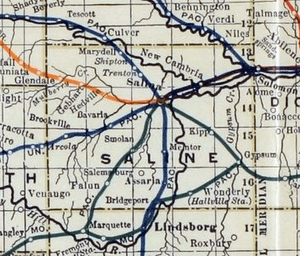
Growth picked up again after the war. The town grew very fast when the Kansas Pacific Railway arrived in 1867. Building the railroad through Salina broke promises made to Indian tribes about their hunting grounds. This led to more conflicts, but by 1868, the U.S. military had removed most tribes from western Kansas. Salina officially became a city in 1870.
Salina's Growth: 1872–1950s
In 1872, the cattle trade came to Salina, turning it into a "cowtown." This brought more money but also a wilder culture. The cattle trade moved west just two years later. In the 1870s, wheat became the main crop. Steam-powered flour mills were built, making agriculture the main part of the local economy. By 1880, Salina was an industrial center with mills and factories. In 1889, the first factory for Lee jeans opened here.
By the early 1900s, Salina's success in wholesale and milling made it grow even more. At one point, it was the third-largest producer in Kansas and the sixth-largest in the United States.
In 1943, the U.S. Army built Smoky Hill Army Airfield near the city. It was a base for strategic bomber planes during World War II. It closed in 1949 but reopened in 1951 as Schilling Air Force Base. This caused Salina's population to grow by almost two-thirds in the 1950s. The base closed for good in 1965. However, Salina took it over and turned it into Salina Municipal Airport and an industrial park. This brought new factories and made manufacturing a key part of the local economy.
Today, the Salina micropolitan area is a hub for trade, transportation, and industry in North Central Kansas.
Geography and Climate
Salina is located in North Central Kansas. It sits where Interstate 70 and Interstate 135 meet. It is about 81 miles (130 km) north of Wichita, Kansas.
The city is in the Smoky Hills region of the Great Plains. The Smoky Hill River flows through the eastern part of the city. The Saline River flows just north of the city.
Salina has a climate that changes between hot, humid summers and cold, dry winters. January is usually the coldest month, and July is the hottest. May gets the most rain.
Salina is in an area that often gets severe thunderstorms. These can bring strong winds, hail, and tornadoes. For example, in 1969, an F3 tornado hit the southern part of the city. It damaged over 100 homes and businesses. Another strong tornado hit in 2008.
The average temperature in Salina is about 56.1°F (13.4°C). Temperatures can reach over 90°F (32°C) about 67 days a year. They can drop below 32°F (0°C) about 115 days a year. The hottest temperature ever recorded was 118°F (48°C) in 1936. The coldest was -31°F (-35°C) in 1905.
Salina gets about 32.2 inches (81.8 cm) of rain each year. Most of the rain falls from May to August. The city also gets about 16.6 inches (42.2 cm) of snow each year.
Population and People
| Historical population | |||
|---|---|---|---|
| Census | Pop. | %± | |
| 1870 | 918 | — | |
| 1880 | 3,111 | 238.9% | |
| 1890 | 6,149 | 97.7% | |
| 1900 | 6,074 | −1.2% | |
| 1910 | 9,688 | 59.5% | |
| 1920 | 15,085 | 55.7% | |
| 1930 | 20,155 | 33.6% | |
| 1940 | 21,073 | 4.6% | |
| 1950 | 26,176 | 24.2% | |
| 1960 | 43,202 | 65.0% | |
| 1970 | 37,714 | −12.7% | |
| 1980 | 41,843 | 10.9% | |
| 1990 | 42,303 | 1.1% | |
| 2000 | 45,679 | 8.0% | |
| 2010 | 47,707 | 4.4% | |
| 2020 | 46,889 | −1.7% | |
| U.S. Decennial Census 2010-2020 |
|||
Salina is the main city of the Salina Micropolitan Statistical Area. This area includes Saline and Ottawa counties.
In 2020, Salina had 46,889 people. Most residents were White (78.14%). There were also Black (3.8%), Native American (0.67%), and Asian (2.34%) residents. About 12.5% of the population was Hispanic or Latino.
About 23.2% of the people were under 18 years old. The average age was 38 years.
Economy and Jobs
Salina is known for its manufacturing, education, health, and social services. Transporting farm products is also a big industry.
Some of the largest employers in Salina include:
- Tony's Pizza: This company makes frozen pizzas and food for schools.
- Philips Lighting: They make lighting products.
- Exide Battery: This company makes batteries.
- Great Plains Manufacturing: They make farm equipment.
- ElDorado National: They build commercial buses.
- Asurion: This company provides insurance.
The cost of living in Salina is lower than the U.S. average. In 2010, the average home value was $109,700.
Major Employers in Salina
Here are some of the top employers in Salina as of 2019:
| # | Employer | # of Employees |
|---|---|---|
| 1 | Salina Regional Health Center | 1,875 |
| 2 | Schwan's Global Supply Chain | 1,700 |
| 3 | Salina United School District (USD) 305 | 1,500 |
| 4 | Great Plains Manufacturing | 1,100 |
| 5 | Exide Technologies | 600 |
| 6 | City of Salina | 425 |
| 7 | Salina Vortex | 375 |
| 8 | REV Group | 300 |
| 9 | Walmart | 250 |
| 10 | Signify | 190 |
Education in Salina
Schools for Kids and Teens
Most students in Salina attend schools in the Salina USD 305 public school district. This district runs twelve schools:
- Salina High School Central (grades 9-12)
- Salina High School South (grades 9-12)
- Lakewood Middle School (grades 6-8)
- Salina South Middle School (grades 6-8)
- Coronado Elementary School (grades K-5)
- Cottonwood Elementary School (grades K-5)
- Grace E. Stewart Elementary School (grades K-5)
- Heusner Elementary School (grades K-5)
- Meadowlark Ridge Elementary School (grades K-5)
- Oakdale Elementary School (grades K-5)
- Schilling Elementary School (grades K-5)
- Sunset Elementary School (grades K-5)
There are also private schools in Salina:
- St. Mary's Grade School (PreK-6), a Catholic school
- Sacred Heart Junior-Senior High School (7-12), a Catholic school
- Cornerstone Classical School (PreK-12)
Colleges and Universities
Salina has several colleges and universities:
- Kansas State University Polytechnic Campus
- Kansas Wesleyan University
- Salina Area Technical College
- University of Kansas School of Medicine, Salina
City Services and Transport
Getting Around Salina
Major highways like Interstate 70 and Interstate 135 pass through Salina. I-135 ends northwest of the city where it meets I-70.
CityGo is the local bus service with five routes. You can also find bus services to other cities like Denver, Colorado and Kansas City, Missouri through Greyhound Lines.
The Salina Municipal Airport is southwest of the city. It mainly serves private planes. It also has commercial flights to Chicago O'Hare and Denver International Airport.
Several freight train lines run through Salina, including Union Pacific Railroad.
City Utilities
The city government handles water, wastewater, and trash services. Westar Energy provides electricity. Most homes use natural gas for heating, supplied by Kansas Gas Service.
Media and News
The Salina Journal is the local daily newspaper.
Salina is an important center for radio and TV in North Central Kansas. Many radio stations broadcast from the city. Salina is part of the Wichita-Hutchinson TV market. Five TV stations broadcast from Salina, including ABC, Fox, and NBC channels. Salina also has special public access TV channels where local people can create their own shows.
Culture and Fun
Events in Salina
- Smoky Hill River Festival: Every June, this festival lasts three and a half days. It features art shows, music, games, and other fun activities. It started in 1976 to celebrate the U.S. Bicentennial.
- All American Fourth and Play Day in the Park: To celebrate Independence Day, the city has games for kids, music, and dance performances in Oakdale Park.
- Smoky Hill Museum Street Fair: In September, this fair includes a parade, a chili cook-off, and demonstrations of old-time skills.
- Christmas Festival: In November, downtown Salina hosts a Christmas festival. It has a 5k run, a mile walk, live music, dance, and a Parade of Lights.
Places to Visit
- Smoky Hill Museum: This museum is run by the city. It has old items, exhibits, and programs about local history, farming, and education. Some items date back to 1879.
- Tony's Pizza Events Center: This is the main place for big indoor events in the city. It has a large arena for concerts and sports. It also has a convention center.
- Rolling Hills Wildlife Adventure: This is a zoo and wildlife park about 6 miles (10 km) west of Salina. It has animal exhibits, an art gallery, and a wildlife museum.
- Indian Rock Park: This park is on the highest point in the area. It offers great views of the city. It also has a fishing pier, a pond, and hiking trails.
- Salina Community Theatre (SCT): This theater puts on many shows each year. They perform both new plays and classic shows.
Religion in Salina
Salina has more than 70 Christian churches. This includes the main churches for the Roman Catholic Diocese of Salina (Sacred Heart Cathedral) and the Episcopal Diocese of Western Kansas (Christ Cathedral). Many religious offices are located in Salina. There is also a Buddhist temple northwest of the city.
Sports in Salina
- Salina had minor league baseball teams from 1898 to 1952.
- The city hosted the Kansas Cagerz and Salina Rattlers basketball teams.
- Salina used to host the national women's basketball tournament for junior colleges.
- It also hosted the Women's Big Eight basketball tournament.
- Salina often hosts state high school sports tournaments for wrestling, volleyball, basketball, softball, and sometimes baseball and football.
- Salina was home to the Salina Bombers, an indoor football team.
- Now, Salina is home to the Salina Liberty, another indoor football team.
- The Kansas Wesleyan University Coyotes are a college sports team based in Salina.
Famous People from Salina
Many notable people have lived in or were born in Salina. These include:
- Marlin Fitzwater: A former White House press secretary.
- Betty Knox: A dancer and war correspondent.
- Steven Hawley: An astronaut.
- John W. Carlin and Bill Graves: Former Governors of Kansas.
- Paul Harvey: A famous radio broadcaster.
- Harry Lee: The inventor of Lee Jeans.
- Adrianna Franch: A goalkeeper for the US Women's National Soccer Team.
See also
 In Spanish: Salina (Kansas) para niños
In Spanish: Salina (Kansas) para niños


